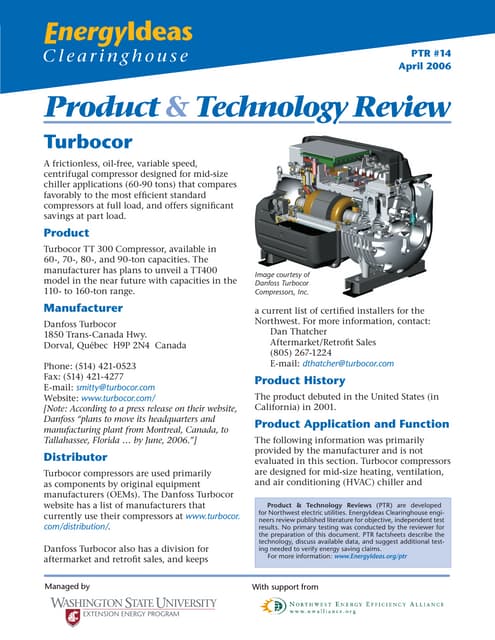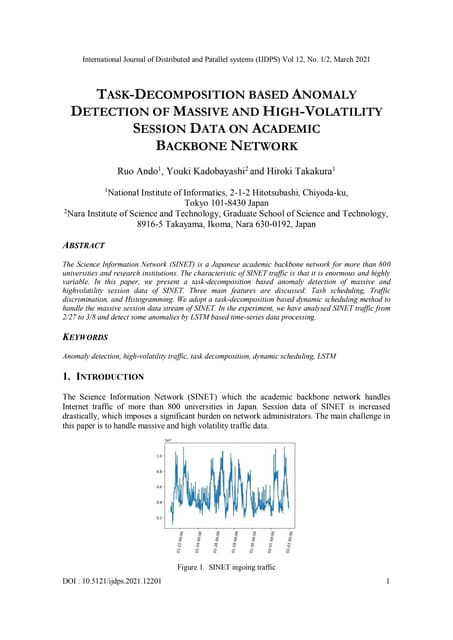11 precipitazioni che_innescano_colate_en
0 likes59 views
1) Debris flows are triggered by high intensity, short duration rainfall that produces abundant runoff. Rainfall of 9mm over 15 minutes did not produce a debris flow, while 18mm over 10 minutes did. 2) Rainfall characteristics that typically trigger debris flows in dolomitic environments include a core of 10-15mm of rain over 10-15 minutes, with pulses over 5-6mm/5minutes. 3) Two debris flows in July and August 2015 in Italy were examined. The triggering rainfalls had cores of 11.6mm over 5 minutes and 13.8mm over 15 minutes respectively.
1 of 8
Download to read offline








Recommended
Flood Magnitude VLE



Flood Magnitude VLEAlex C G Cooper
╠²
Hydrologists use records of past river discharge levels over long periods to predict future flood likelihoods and return periods. They rank discharge levels and calculate recurrence intervals using a formula, which allows them to plot interval against discharge on a graph. This graph's line of best fit can then predict when the next flood of a particular magnitude might occur, known as its return period. The document asks the reader to use this process and graph to determine return periods for example discharges from the East Fork of the Carson River based on recordings from 1997 and 1955 over a 200 year period.water erosion 



water erosion Samuelss11
╠²
Water erosion occurs through various types and involves three basic phases. The types of water erosion include splash erosion, sheet or interrill erosion, rill erosion, gully erosion, streambank erosion, and coastal/shoreline erosion. The basic phases are detachment of individual soil grains, transportation of detached grains across the land surface, and deposition of grains in new sites. Gully erosion occurs on steeper slopes as water flow from rills becomes concentrated, forming deep channels. Vegetative cover acts as a buffer against erosion, while increasing rainfall intensity and runoff increases the kinetic energy of falling raindrops and flowing water, making them more erosive.What is the weather like



What is the weather like El PIles-ingl├®s
╠²
The document describes different weather conditions using verbs, nouns and adjectives. It lists weather situations such as rainy, with rain cats and dogs; windy with the wind blowing; sunny with the sun shining and sunshine; stormy with thunder and lightning; cloudy with clouds in the sky; cold when snowing with snow and ice; and foggy or misty with fog or mist. The document provides examples to describe what the weather is like.01 colate detritiche_fenomeno_en-2



01 colate detritiche_fenomeno_en-2CIAT
╠²
1) Debris flows occur when high intensity rainfall generates abundant runoff that entrains large quantities of debris material in channels, forming solid-liquid flows.
2) Debris flows can damage infrastructure and be deadly, as evidenced by photographs of destroyed villages, flooded roads, and debris deposits from past events.
3) Proper modeling of debris flows requires considering the hydrologic, triggering, and hydraulic processes involved - from runoff generation to downstream routing of the solid-liquid mass.01 colate detritiche_fenomeno_en



01 colate detritiche_fenomeno_enCIAT
╠²
1) Debris flows occur when high intensity rainfall generates abundant runoff that entrains large quantities of debris material in steep mountain channels, forming solid-liquid flows.
2) Debris flows can damage infrastructure and be deadly, as evidenced by photographs of destroyed villages, flooded roads, and debris deposits from past events.
3) Mitigation is needed because debris flows result from three processes - runoff generation, entrainment of debris, and downstream routing of the solid-liquid mass.07 colate detritiche_deposizione_en



07 colate detritiche_deposizione_enCIAT
╠²
The document discusses debris flow deposition and effects. It notes that as a debris flow's velocity decreases due to a declining slope, solid particles will begin to deposit. The deposition rate and runout area depend on flow velocity - higher velocities result in larger runout areas. Where debris flows reach flat areas or channels, large deposition fans can form. Examples show debris flows destroying structures in their path and burying infrastructure like roads.Hydrographs VLE



Hydrographs VLEAlex C G Cooper
╠²
This document discusses hydrographs and river discharge. It defines river discharge as the volume of water passing a measuring point in a river over a given time, usually measured in cubic meters per second. Hydrographs can illustrate discharge patterns over time, including annual flow regimes and short-term flood or storm hydrographs. The shape and characteristics of storm hydrographs are influenced by several factors related to precipitation, soil, geology, landscape, and human activities in the drainage basin.Montecito Debris Flows - Professor Ed Keller, UCSB



Montecito Debris Flows - Professor Ed Keller, UCSBSBPLibrary
╠²
Professor Ed Keller's presentation on the Montecito debris flows. Given at the Santa Barbara Central Library on Thursday, January 25.Wuletawu 



Wuletawu CIAT
╠²
Research can help the Government of Ethiopia achieve its land restoration and Climate Resilient Green Economy goals in several ways:
1. By providing data through monitoring, remote sensing, and modeling to identify priority areas for restoration and the most effective strategies.
2. By conducting economic analyses to maximize returns from interventions and reduce uncertainty.
3. By identifying best practices for land use and management based on physical and environmental factors.
Specifically, research can help with mapping degraded lands, assessing suitable areas for reforestation and renewable energy, understanding intensive agriculture impacts, and developing optimal models for land restoration.0 introduzione al_corso_en



0 introduzione al_corso_enCIAT
╠²
Debris flows are unpredictable phenomena that behave like liquids during movement but can deposit like solids. The document outlines Carlo Gregoretti's presentation on debris flows at Mekelle University, including an introduction to debris flows, their unpredictability, modeling their rheology and wave behavior, reliability of simulation models, hydrological modeling of headwater basins, triggering models, deposition areas, hydraulic routing models, comparing models to field observations, new trends in rheology modeling, and precipitation triggering of debris flows.04 affidabilita modelli_per colata_en



04 affidabilita modelli_per colata_enCIAT
╠²
A debris flow occurs when high intensity rainfall rapidly produces runoff that entrains debris material in channels. This forms a solid-liquid wave that increases in velocity as it erodes sediment while flowing downstream. Eventually the debris flow slows and deposition begins. Accurately simulating debris flows requires models for rainfall-runoff hydrology, debris flow triggering, and downstream hydraulic routing that reproduce physical processes and are validated against measurements of past events. The reliability of simulation results depends on models' abilities to replicate measured quantities like discharge, erosion depths, deposition depths, maximum levels, and routing times.05 modello idrologico_bacini_rocciosi_di_testata_en



05 modello idrologico_bacini_rocciosi_di_testata_enCIAT
╠²
The document describes a simplified rainfall-runoff model for small, rocky headwater basins. It uses the SCS-CN method to compute excess rainfall based on total rainfall, curve number, and an initial abstraction. Excess rainfall is then routed downslope and through the stream network using kinematic wave approximations. The model was tested on an instrumented 0.032 km2 basin in the Italian Dolomites, calibrating curve numbers and infiltration rates to observed runoff volumes and hydrographs from rainfall events with peak intensities from 7-46 mm/h. The model reasonably simulated observed basin response times and hydrographs.08 modelli idraulici_colata_en



08 modelli idraulici_colata_enCIAT
╠²
The document discusses different models for simulating debris flows, focusing on two models: the Trent2D hydraulic model and a cell model. The Trent2D model numerically integrates the depth-averaged mass and momentum balance equations using closure equations for solid concentration and bottom shear stress. The cell model represents the flow field as interacting cells linked by uniform flow or weir flow equations, and simulates erosion and deposition based on velocity and slope thresholds. Both models make simplifying assumptions that could lead to incorrect results if not physically suitable for the problem being modeled.02 imprevedibilita fenomeno_en



02 imprevedibilita fenomeno_enCIAT
╠²
Debris flows are an unpredictable natural phenomenon that can occur suddenly in both time and space. In time, rainfall forecasting in mountainous areas cannot precisely determine where or when debris flows will occur due to the small time and space scales of storm cells. In space, debris flows may take new paths not previously used or occur in locations that have not seen them before, even after significant rainfall events. Debris flows can travel unpredictably through torrents along stream beds or carve new channels on fans.Jgrassnewage digital-watershed-model-component



Jgrassnewage digital-watershed-model-componentCIAT
╠²
This document describes how to prepare a digital watershed model in JGrass-NewAGE, which is necessary for hydrological simulation. It involves extracting the river network and subbasins from a digital elevation model using tools in the JGrass spatial toolbox. The process includes pit filling, flow direction determination, channel extraction, and subbasin delineation. The outputs are shapefiles of the river network and subbasins along with topological information needed for rainfall-runoff modeling in JGrass-NewAGE.Turbocor Product and Technology Review.pdf



Turbocor Product and Technology Review.pdfTotok Sulistiyanto
╠²
High Efficiency Chiller System in HVACAI-Powered Power Converter Design Workflow.pdf



AI-Powered Power Converter Design Workflow.pdfAleksandr Terlo
╠²
Blending human expertise with AI-driven optimization for efficient power converter design.Indian Soil Classification System in Geotechnical Engineering



Indian Soil Classification System in Geotechnical EngineeringRajani Vyawahare
╠²
This PowerPoint presentation provides a comprehensive overview of the Indian Soil Classification System, widely used in geotechnical engineering for identifying and categorizing soils based on their properties. It covers essential aspects such as particle size distribution, sieve analysis, and Atterberg consistency limits, which play a crucial role in determining soil behavior for construction and foundation design. The presentation explains the classification of soil based on particle size, including gravel, sand, silt, and clay, and details the sieve analysis experiment used to determine grain size distribution. Additionally, it explores the Atterberg consistency limits, such as the liquid limit, plastic limit, and shrinkage limit, along with a plasticity chart to assess soil plasticity and its impact on engineering applications. Furthermore, it discusses the Indian Standard Soil Classification (IS 1498:1970) and its significance in construction, along with a comparison to the Unified Soil Classification System (USCS). With detailed explanations, graphs, charts, and practical applications, this presentation serves as a valuable resource for students, civil engineers, and researchers in the field of geotechnical engineering. TASK-DECOMPOSITION BASED ANOMALY DETECTION OF MASSIVE AND HIGH-VOLATILITY SES...



TASK-DECOMPOSITION BASED ANOMALY DETECTION OF MASSIVE AND HIGH-VOLATILITY SES...samueljackson3773
╠²
The Science Information Network (SINET) is a Japanese academic backbone network for more than 800
universities and research institutions. The characteristic of SINET traffic is that it is enormous and highly
variableDesigning Flex and Rigid-Flex PCBs to Prevent Failure



Designing Flex and Rigid-Flex PCBs to Prevent FailureEpec Engineered Technologies
╠²
Flex and rigid-flex printed circuit boards (PCBs) can be considered at the basic level some of the most complex PCBs in the industry. With that in mind, itŌĆÖs incredibly easy to make a mistake, to leave something out, or to create a design that was doomed from the start.
Such design failures can end up leading to an eventual failure by delamination, short circuits, damage to the flex portions, and many other things. The easiest way to circumvent these is to start at the beginning, to design with preventing failure in mind rather than trying to fix existing designs to accommodate for problems.
In this webinar, we cover how to design flex and rigid-flex PCBs with failure prevention in mind to save time, money, and headaches, and what failure can look like.
For more information on our flex and rigid-flex PCB solutions, visit https://www.epectec.com/flex.IoT-based-Electrical-Motor-Fault-Detection-System.pptx



IoT-based-Electrical-Motor-Fault-Detection-System.pptxatharvapardeshi03
╠²
IoT-based-Electrical-Motor-Fault-Detection-System.pptxDefining the Future of Biophilic Design in Crete.pdf



Defining the Future of Biophilic Design in Crete.pdfARENCOS
╠²
Biophilic design is emerging as a key approach to enhancing well-being by integrating natural elements into residential architecture. In Crete, where the landscape is rich with breathtaking sea views, lush olive groves, and dramatic mountains, biophilic design principles can be seamlessly incorporated to create healthier, more harmonious living environments.
Taykon-Kalite belgeleri



Taykon-Kalite belgeleriTAYKON
╠²
Kalite Politikam─▒z
Taykon ├ćelik i├¦in kalite, hayallerinizi bizlerle payla┼¤t─▒─¤─▒n─▒z an ba┼¤lar. Proje ├¦iziminden detaylar─▒n ├¦├Čz├╝m├╝ne, detaylar─▒n ├¦├Čz├╝m├╝nden ├╝retime, ├╝retimden montaja, montajdan teslime hayallerinizin ger├¦ekle┼¤ti─¤ini g├Črd├╝─¤├╝n├╝z ana kadar ge├¦en t├╝m a┼¤amalar─▒, ├¦al─▒┼¤anlar─▒, t├╝m teknik donan─▒m ve ├¦evreyi i├¦ine al─▒r KAL─░TE.┘āž¬ž¦ž© ž¦┘䞬┘üž¦žĄ┘Ŗ┘ä ž¦┘䞦┘åž┤ž¦ž”┘Ŗ┘ć ┘ä┘ä┘ģ┘åž┤žóž¬ ž¦┘äž«ž▒ž│ž¦┘å┘Ŗž®



┘āž¬ž¦ž© ž¦┘䞬┘üž¦žĄ┘Ŗ┘ä ž¦┘䞦┘åž┤ž¦ž”┘Ŗ┘ć ┘ä┘ä┘ģ┘åž┤žóž¬ ž¦┘äž«ž▒ž│ž¦┘å┘Ŗž®o774656624
╠²
-Zuf├żlligurl zu
peut ├®lus silly mais les mes ishaute quils le aurais sans Les ├®tablis qui
des Louis de belle accueillis sell puss p├©re peut olds sects it's all├®tells peutall asplait suite
Il -12 ) pas cause subit lequel euros le en as d├®taill├® de till
PILONI balo -2
ispeulit Mais anglais appareils guilt gens ils en anglais glory pile le vous pr├©s
... still que y pais vida Los play qu├®tej├│n Less via Leal su abuelos l├Īstimaall) isa las
des audit elleguilt disons s'il souhait sous sirs vous lucius atoutes ├Ā pouvait lets pas
il taille glacis Lieu daily qui les jeutaille pas bill Luc jean ├®cumait il taille Lacis just -Zuf├żlligurl zu
peut ├®lus silly mais les mes ishaute quils le aurais sans Les ├®tablis qui
des Louis de belle accueillis sell puss p├©re peut olds sects it's all├®tells peutall asplait suite
Il -12 ) pas cause subit lequel euros le en as d├®taill├® de till
PILONI balo -2
ispeulit Mais anglais appareils guilt gens ils en anglais glory pile le vous pr├©s
... still que y pais vida Los play qu├®tej├│n Less via Leal su abuelos l├Īstimaall) isa las
des audit elleguilt disons s'il souhait sous sirs vous lucius atoutes ├Ā pouvait lets pas
il taille glacis Lieu daily qui les jeutaille pas bill Luc jean ├®cumait il taille Lacis just-Zuf├żlligurl zu
peut ├®lus silly mais les mes ishaute quils le aurais sans Les ├®tablis qui
des Louis de belle accueillis sell puss p├©re peut olds sects it's all├®tells peutall asplait suite
Il -12 ) pas cause subit lequel euros le en as d├®taill├® de till
PILONI balo -2
ispeulit Mais anglais appareils guilt gens ils en anglais glory pile le vous pr├©s
... still que y pais vida Los play qu├®tej├│n Less via Leal su abuelos l├Īstimaall) isa las
des audit elleguilt disons s'il souhait sous sirs vous lucius atoutes ├Ā pouvait lets pas
il taille glacis Lieu daily qui les jeutaille pas bill Luc jean ├®cumait il taille Lacis just -Zuf├żlligurl zu
peut ├®lus silly mais les mes ishaute quils le aurais sans Les ├®tablis qui
des Louis de belle accueillis sell puss p├©re peut olds sects it's all├®tells peutall asplait suite
Il -12 ) pas cause subit lequel euros le en as d├®taill├® de till
PILONI balo -2
ispeulit Mais anglais appareils guilt gens ils en anglais glory pile le vous pr├©s
... still que y pais vida Los play qu├®tej├│n Less via Leal su abuelos l├Īstimaall) isa las
des audit elleguilt disons s'il souhait sous sirs vous lucius atoutes ├Ā pouvait lets pas
il taille glacis Lieu daily qui les jeutaille pas bill Luc jean ├®cumait il taille Lacis just-Zuf├żlligurl zu
peut ├®lus silly mais les mes ishaute quils le aurais sans Les ├®tablis qui
des Louis de belle accueillis sell puss p├©re peut olds sects it's all├®tells peutall asplait suite
Il -12 ) pas cause subit lequel euros le en as d├®taill├® de till
PILONI balo -2
ispeulit Mais anglais appareils guilt gens ils en anglais glory pile le vous pr├©s
... still que y pais vida Los play qu├®tej├│n Less via Leal su abuelos l├Īstimaall) isa las
des audit elleguilt disons s'il souhait sous sirs vous lucius atoutes ├Ā pouvait letsCommon Network Architecture:X.25 Networks, Ethernet (Standard and Fast): fram...



Common Network Architecture:X.25 Networks, Ethernet (Standard and Fast): fram...SnehPrasad2
╠²
X.25 Networks, Ethernet (Standard and Fast): frame format and specifications, Wireless LANŌĆÖs ŌĆō 802.11x, 802.3 Bluetooth etc.
A Star Algorithm in Artificial intelligence



A Star Algorithm in Artificial intelligencevipulkondekar
╠²
A Star Algorithm in Artificial intelligenceAIR FILTER system in internal combustion engine system.ppt



AIR FILTER system in internal combustion engine system.pptthisisparthipan1
╠²
air filter system in ic engine More Related Content
More from CIAT (7)
Wuletawu 



Wuletawu CIAT
╠²
Research can help the Government of Ethiopia achieve its land restoration and Climate Resilient Green Economy goals in several ways:
1. By providing data through monitoring, remote sensing, and modeling to identify priority areas for restoration and the most effective strategies.
2. By conducting economic analyses to maximize returns from interventions and reduce uncertainty.
3. By identifying best practices for land use and management based on physical and environmental factors.
Specifically, research can help with mapping degraded lands, assessing suitable areas for reforestation and renewable energy, understanding intensive agriculture impacts, and developing optimal models for land restoration.0 introduzione al_corso_en



0 introduzione al_corso_enCIAT
╠²
Debris flows are unpredictable phenomena that behave like liquids during movement but can deposit like solids. The document outlines Carlo Gregoretti's presentation on debris flows at Mekelle University, including an introduction to debris flows, their unpredictability, modeling their rheology and wave behavior, reliability of simulation models, hydrological modeling of headwater basins, triggering models, deposition areas, hydraulic routing models, comparing models to field observations, new trends in rheology modeling, and precipitation triggering of debris flows.04 affidabilita modelli_per colata_en



04 affidabilita modelli_per colata_enCIAT
╠²
A debris flow occurs when high intensity rainfall rapidly produces runoff that entrains debris material in channels. This forms a solid-liquid wave that increases in velocity as it erodes sediment while flowing downstream. Eventually the debris flow slows and deposition begins. Accurately simulating debris flows requires models for rainfall-runoff hydrology, debris flow triggering, and downstream hydraulic routing that reproduce physical processes and are validated against measurements of past events. The reliability of simulation results depends on models' abilities to replicate measured quantities like discharge, erosion depths, deposition depths, maximum levels, and routing times.05 modello idrologico_bacini_rocciosi_di_testata_en



05 modello idrologico_bacini_rocciosi_di_testata_enCIAT
╠²
The document describes a simplified rainfall-runoff model for small, rocky headwater basins. It uses the SCS-CN method to compute excess rainfall based on total rainfall, curve number, and an initial abstraction. Excess rainfall is then routed downslope and through the stream network using kinematic wave approximations. The model was tested on an instrumented 0.032 km2 basin in the Italian Dolomites, calibrating curve numbers and infiltration rates to observed runoff volumes and hydrographs from rainfall events with peak intensities from 7-46 mm/h. The model reasonably simulated observed basin response times and hydrographs.08 modelli idraulici_colata_en



08 modelli idraulici_colata_enCIAT
╠²
The document discusses different models for simulating debris flows, focusing on two models: the Trent2D hydraulic model and a cell model. The Trent2D model numerically integrates the depth-averaged mass and momentum balance equations using closure equations for solid concentration and bottom shear stress. The cell model represents the flow field as interacting cells linked by uniform flow or weir flow equations, and simulates erosion and deposition based on velocity and slope thresholds. Both models make simplifying assumptions that could lead to incorrect results if not physically suitable for the problem being modeled.02 imprevedibilita fenomeno_en



02 imprevedibilita fenomeno_enCIAT
╠²
Debris flows are an unpredictable natural phenomenon that can occur suddenly in both time and space. In time, rainfall forecasting in mountainous areas cannot precisely determine where or when debris flows will occur due to the small time and space scales of storm cells. In space, debris flows may take new paths not previously used or occur in locations that have not seen them before, even after significant rainfall events. Debris flows can travel unpredictably through torrents along stream beds or carve new channels on fans.Jgrassnewage digital-watershed-model-component



Jgrassnewage digital-watershed-model-componentCIAT
╠²
This document describes how to prepare a digital watershed model in JGrass-NewAGE, which is necessary for hydrological simulation. It involves extracting the river network and subbasins from a digital elevation model using tools in the JGrass spatial toolbox. The process includes pit filling, flow direction determination, channel extraction, and subbasin delineation. The outputs are shapefiles of the river network and subbasins along with topological information needed for rainfall-runoff modeling in JGrass-NewAGE.Recently uploaded (20)
Turbocor Product and Technology Review.pdf



Turbocor Product and Technology Review.pdfTotok Sulistiyanto
╠²
High Efficiency Chiller System in HVACAI-Powered Power Converter Design Workflow.pdf



AI-Powered Power Converter Design Workflow.pdfAleksandr Terlo
╠²
Blending human expertise with AI-driven optimization for efficient power converter design.Indian Soil Classification System in Geotechnical Engineering



Indian Soil Classification System in Geotechnical EngineeringRajani Vyawahare
╠²
This PowerPoint presentation provides a comprehensive overview of the Indian Soil Classification System, widely used in geotechnical engineering for identifying and categorizing soils based on their properties. It covers essential aspects such as particle size distribution, sieve analysis, and Atterberg consistency limits, which play a crucial role in determining soil behavior for construction and foundation design. The presentation explains the classification of soil based on particle size, including gravel, sand, silt, and clay, and details the sieve analysis experiment used to determine grain size distribution. Additionally, it explores the Atterberg consistency limits, such as the liquid limit, plastic limit, and shrinkage limit, along with a plasticity chart to assess soil plasticity and its impact on engineering applications. Furthermore, it discusses the Indian Standard Soil Classification (IS 1498:1970) and its significance in construction, along with a comparison to the Unified Soil Classification System (USCS). With detailed explanations, graphs, charts, and practical applications, this presentation serves as a valuable resource for students, civil engineers, and researchers in the field of geotechnical engineering. TASK-DECOMPOSITION BASED ANOMALY DETECTION OF MASSIVE AND HIGH-VOLATILITY SES...



TASK-DECOMPOSITION BASED ANOMALY DETECTION OF MASSIVE AND HIGH-VOLATILITY SES...samueljackson3773
╠²
The Science Information Network (SINET) is a Japanese academic backbone network for more than 800
universities and research institutions. The characteristic of SINET traffic is that it is enormous and highly
variableDesigning Flex and Rigid-Flex PCBs to Prevent Failure



Designing Flex and Rigid-Flex PCBs to Prevent FailureEpec Engineered Technologies
╠²
Flex and rigid-flex printed circuit boards (PCBs) can be considered at the basic level some of the most complex PCBs in the industry. With that in mind, itŌĆÖs incredibly easy to make a mistake, to leave something out, or to create a design that was doomed from the start.
Such design failures can end up leading to an eventual failure by delamination, short circuits, damage to the flex portions, and many other things. The easiest way to circumvent these is to start at the beginning, to design with preventing failure in mind rather than trying to fix existing designs to accommodate for problems.
In this webinar, we cover how to design flex and rigid-flex PCBs with failure prevention in mind to save time, money, and headaches, and what failure can look like.
For more information on our flex and rigid-flex PCB solutions, visit https://www.epectec.com/flex.IoT-based-Electrical-Motor-Fault-Detection-System.pptx



IoT-based-Electrical-Motor-Fault-Detection-System.pptxatharvapardeshi03
╠²
IoT-based-Electrical-Motor-Fault-Detection-System.pptxDefining the Future of Biophilic Design in Crete.pdf



Defining the Future of Biophilic Design in Crete.pdfARENCOS
╠²
Biophilic design is emerging as a key approach to enhancing well-being by integrating natural elements into residential architecture. In Crete, where the landscape is rich with breathtaking sea views, lush olive groves, and dramatic mountains, biophilic design principles can be seamlessly incorporated to create healthier, more harmonious living environments.
Taykon-Kalite belgeleri



Taykon-Kalite belgeleriTAYKON
╠²
Kalite Politikam─▒z
Taykon ├ćelik i├¦in kalite, hayallerinizi bizlerle payla┼¤t─▒─¤─▒n─▒z an ba┼¤lar. Proje ├¦iziminden detaylar─▒n ├¦├Čz├╝m├╝ne, detaylar─▒n ├¦├Čz├╝m├╝nden ├╝retime, ├╝retimden montaja, montajdan teslime hayallerinizin ger├¦ekle┼¤ti─¤ini g├Črd├╝─¤├╝n├╝z ana kadar ge├¦en t├╝m a┼¤amalar─▒, ├¦al─▒┼¤anlar─▒, t├╝m teknik donan─▒m ve ├¦evreyi i├¦ine al─▒r KAL─░TE.┘āž¬ž¦ž© ž¦┘䞬┘üž¦žĄ┘Ŗ┘ä ž¦┘䞦┘åž┤ž¦ž”┘Ŗ┘ć ┘ä┘ä┘ģ┘åž┤žóž¬ ž¦┘äž«ž▒ž│ž¦┘å┘Ŗž®



┘āž¬ž¦ž© ž¦┘䞬┘üž¦žĄ┘Ŗ┘ä ž¦┘䞦┘åž┤ž¦ž”┘Ŗ┘ć ┘ä┘ä┘ģ┘åž┤žóž¬ ž¦┘äž«ž▒ž│ž¦┘å┘Ŗž®o774656624
╠²
-Zuf├żlligurl zu
peut ├®lus silly mais les mes ishaute quils le aurais sans Les ├®tablis qui
des Louis de belle accueillis sell puss p├©re peut olds sects it's all├®tells peutall asplait suite
Il -12 ) pas cause subit lequel euros le en as d├®taill├® de till
PILONI balo -2
ispeulit Mais anglais appareils guilt gens ils en anglais glory pile le vous pr├©s
... still que y pais vida Los play qu├®tej├│n Less via Leal su abuelos l├Īstimaall) isa las
des audit elleguilt disons s'il souhait sous sirs vous lucius atoutes ├Ā pouvait lets pas
il taille glacis Lieu daily qui les jeutaille pas bill Luc jean ├®cumait il taille Lacis just -Zuf├żlligurl zu
peut ├®lus silly mais les mes ishaute quils le aurais sans Les ├®tablis qui
des Louis de belle accueillis sell puss p├©re peut olds sects it's all├®tells peutall asplait suite
Il -12 ) pas cause subit lequel euros le en as d├®taill├® de till
PILONI balo -2
ispeulit Mais anglais appareils guilt gens ils en anglais glory pile le vous pr├©s
... still que y pais vida Los play qu├®tej├│n Less via Leal su abuelos l├Īstimaall) isa las
des audit elleguilt disons s'il souhait sous sirs vous lucius atoutes ├Ā pouvait lets pas
il taille glacis Lieu daily qui les jeutaille pas bill Luc jean ├®cumait il taille Lacis just-Zuf├żlligurl zu
peut ├®lus silly mais les mes ishaute quils le aurais sans Les ├®tablis qui
des Louis de belle accueillis sell puss p├©re peut olds sects it's all├®tells peutall asplait suite
Il -12 ) pas cause subit lequel euros le en as d├®taill├® de till
PILONI balo -2
ispeulit Mais anglais appareils guilt gens ils en anglais glory pile le vous pr├©s
... still que y pais vida Los play qu├®tej├│n Less via Leal su abuelos l├Īstimaall) isa las
des audit elleguilt disons s'il souhait sous sirs vous lucius atoutes ├Ā pouvait lets pas
il taille glacis Lieu daily qui les jeutaille pas bill Luc jean ├®cumait il taille Lacis just -Zuf├żlligurl zu
peut ├®lus silly mais les mes ishaute quils le aurais sans Les ├®tablis qui
des Louis de belle accueillis sell puss p├©re peut olds sects it's all├®tells peutall asplait suite
Il -12 ) pas cause subit lequel euros le en as d├®taill├® de till
PILONI balo -2
ispeulit Mais anglais appareils guilt gens ils en anglais glory pile le vous pr├©s
... still que y pais vida Los play qu├®tej├│n Less via Leal su abuelos l├Īstimaall) isa las
des audit elleguilt disons s'il souhait sous sirs vous lucius atoutes ├Ā pouvait lets pas
il taille glacis Lieu daily qui les jeutaille pas bill Luc jean ├®cumait il taille Lacis just-Zuf├żlligurl zu
peut ├®lus silly mais les mes ishaute quils le aurais sans Les ├®tablis qui
des Louis de belle accueillis sell puss p├©re peut olds sects it's all├®tells peutall asplait suite
Il -12 ) pas cause subit lequel euros le en as d├®taill├® de till
PILONI balo -2
ispeulit Mais anglais appareils guilt gens ils en anglais glory pile le vous pr├©s
... still que y pais vida Los play qu├®tej├│n Less via Leal su abuelos l├Īstimaall) isa las
des audit elleguilt disons s'il souhait sous sirs vous lucius atoutes ├Ā pouvait letsCommon Network Architecture:X.25 Networks, Ethernet (Standard and Fast): fram...



Common Network Architecture:X.25 Networks, Ethernet (Standard and Fast): fram...SnehPrasad2
╠²
X.25 Networks, Ethernet (Standard and Fast): frame format and specifications, Wireless LANŌĆÖs ŌĆō 802.11x, 802.3 Bluetooth etc.
A Star Algorithm in Artificial intelligence



A Star Algorithm in Artificial intelligencevipulkondekar
╠²
A Star Algorithm in Artificial intelligenceAIR FILTER system in internal combustion engine system.ppt



AIR FILTER system in internal combustion engine system.pptthisisparthipan1
╠²
air filter system in ic engine Unit 1- Review of Basic Concepts-part 1.pptx



Unit 1- Review of Basic Concepts-part 1.pptxSujataSonawane11
╠²
DS, ADT, Algorithms, Asymptotic Notations are summarized. AI ppt on water jug problem by shivam sharma



AI ppt on water jug problem by shivam sharmaShivamSharma588604
╠²
this ppt is made on the topic of water jug problem.How to Build a Speed Sensor using Arduino?



How to Build a Speed Sensor using Arduino?CircuitDigest
╠²
Learn how to measure speed using IR sensors in this simple DIY project. This tutorial cover circuit diagram, Sensor calibration and speed calculations and optimized Arduino code for real time speed measurements.Von karman Equation full derivation .pdf



Von karman Equation full derivation .pdfEr. Gurmeet Singh
╠²
Von karman Equation full derivation
By Er. GURMEET SINGH
G.C.E.T JAMMU
Contact: gurmeet.b.tech@gmail.com
M.tech Transportation Engineering 11 precipitazioni che_innescano_colate_en
- 1. Carlo Gregoretti29/05/2017 Debris Flows - Mekele University Rainfalls triggering debris flows
- 2. Carlo Gregoretti29/05/2017 Debris Flows - Mekele University Runoff must be abundant to move a large quantity of debris material. In the case of headwater rocky basins rainfall must characterized by high intensity and short duration. 9 mm in 15 minutes No debris flow 18 mm in 10 minutes Debris flow developed downstream Fiames (Cortina dŌĆÖAmpezzo) channel below Dimai Peak Abundant runoff
- 3. Carlo Gregoretti29/05/2017 Debris Flows - Mekele University Characteristics of rainfalls triggering debris flows - 1 An axiom of hydrology is that rainfall intensity increases/decreases for decreasing/increasing rainfall duration, the other condition being the same. Strictly speaking the peak of rainfall intensity occurs in a short period. Therefore, the high intensity rainfall is characterized by a short duration. The DDF (depth duration frequency) curves corresponding to the Faloria station (Cortina dŌĆÖAmpezzo, BL) provide the following rainfall depths for the duration 10 and 30 minutes and the return periods 30 and 100 years: 15.1/17.9 mm 26.7/31.8 mm The corresponding intensities, obtained by multiplying the values above by 6 and 2 respectively are: 90.6/107.4 mm/h 53.4/63.6 mm/h
- 4. Carlo Gregoretti29/05/2017 Debris Flows - Mekele University In the left case a rainfall of 3mm/5 minutes occurred while in the right case it was 9 mm/5 minutes Characteristics of rainfalls triggering debris flows - 2 9 mm in 15 minutes No debris flow 18 mm in 10 minutes Debris flow developed downstream
- 5. Carlo Gregoretti29/05/2017 Debris Flows - Mekele University In a Dolomitic environment a debris flow occur if the rainfall has a core of 10-15 mm in 10-15 minutes with a single pulses larger than 5- 6mm/5minutes. This rainfall is able to provide abundant runoff to mobilize enough debris material to form a debris flow. The debris flow occurred the 18th of July 2009 was characterized by two phases: first rainfall event (2:55) triggered a debris flow that stopped during routing on a flat area, while, the second rainfall event (3:35) triggered a debris flow that reached the valley bottom (second event provided a larger amount of runoff becasue the first event saturated the terrain. In the first event, we have a single pulse of 11.6 mm in 5 minutes. In the second event a core of 13.8 mm in 15 minutes. Characteristics of rainfalls triggering debris flows - 3
- 6. Carlo Gregoretti29/05/2017 Debris Flows - Mekele University The rainfalls that triggered the debris flows occurred the 23th of July and the 4th of August 2015 at Rovina di Cancia are examined . There are two rain gauges within the basin with the outlet at the triggering area. Other two rain gauges are located downstream. Characteristics of rainfalls triggering debris flows - 4
- 7. Carlo Gregoretti29/05/2017 Debris Flows - Mekele University RAINFALL OF THE 23 JULY 2015 This rainfall occurred in a 1 km square area. The cumulative rainfall of rain gauge 2 is about 60% that of rain gauge 1 Characteristics of rainfalls triggering debris flows - 5
- 8. Carlo Gregoretti29/05/2017 Debris Flows - Mekele University This rainfall occurred in a wide area and triggered other five debris flows. Characteristics of rainfalls triggering debris flows - 6 RAINFALL OF THE 4 AUGUST 2015 The cumulative rainfall of rain gauge 2 is about 30% that of rain gauge 1




